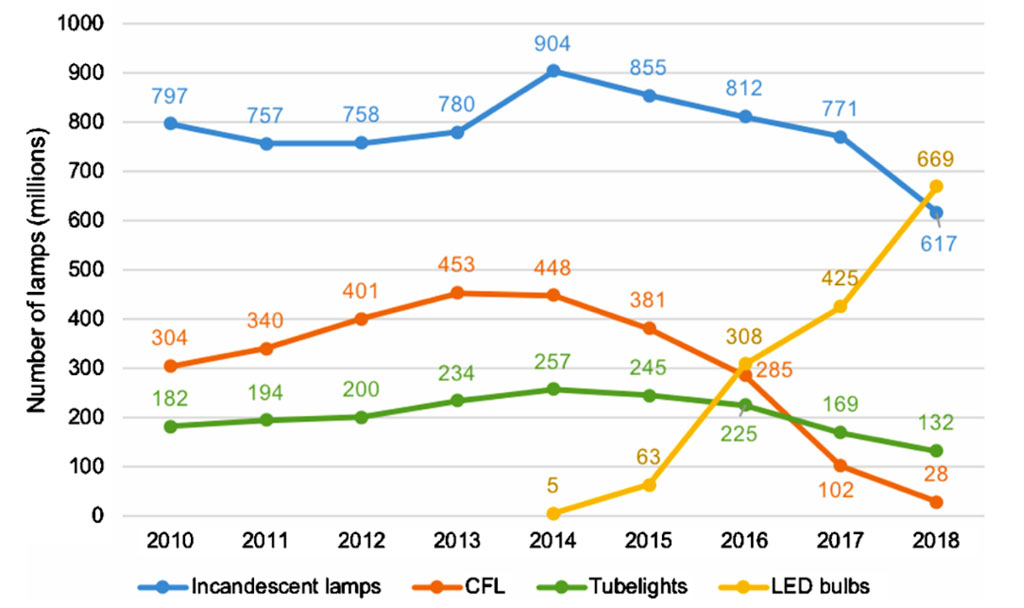
Guest post: How energy-efficient LED bulbs lit up India in just five years

Guest authors
03.31.20
Guest authors
31.03.2020 | 1:15pmInnovating and scaling up low-carbon technologies is a fundamental part of the global need to tackle climate change.
However, this can be a particular challenge for large developing countries such as India. This is because climate-mitigation technologies can have high upfront costs, whereas achieving rapid economic development often relies on relatively cheap large-scale energy sources, which are, generally, fossil fuels.
Developing countries often have limited capabilities to innovate and produce cutting-edge low-carbon technologies themselves and, therefore, need to import them.
In order to achieve global climate goals, a key question must be answered: how can developing countries rapidly scale-up emerging energy-efficient technologies while also advancing their technological capabilities?
In a new research paper, published in the journal Energy Research & Social Science, we investigate this question through an analysis of the unprecedented expansion of India’s light emitting diode (LED) bulb market.
Falling prices and growing market
Light bulbs are one of the most ubiquitous electric appliances around the world, consuming about 15% of the global electricity.
Over the past decade, the global lighting market has been transitioning towards LED lighting technology, which is up to 75% more energy efficient than traditional incandescent and compact fluorescent (CFL) bulbs. According to the Organisation for Economic Co-operation and Development (OECD), global LED bulb prices have fallen by an order of magnitude during this period.
Our study, jointly released by the Smith School of Enterprise and the Environment, University of Oxford and the Belfer Center for Science and International Affairs and John A. Paulson School of Engineering and Applied Sciences, Harvard University, analyses the enormous growth of LED use in India between 2014 and 2018.
India’s LED lighting market grew 130-fold within five years, skyrocketing from annual sales of 5m bulbs per year in 2014 to about 670m in 2018. This resulted in 30 terawatt hours (TWh) of annual energy savings – roughly enough to power 28m average Indian households or the whole of Denmark for a year.
The price of an LED bulb in India also dropped dramatically, from 400 Indian rupees (around £4.50) in 2014 to about 70 rupees (£0.78) just five years later.
Over the same period, the number of LEDs in India has increased rapidly. As the chart below illustrates, the market share for LEDs (yellow line) grew from 0.3% to 46%, with sales surpassing those of incandescent (blue), CFL (orange) and tubelight (green) lamps in 2018.

As LED lamps became “cheaper than bread”, India underwent a lighting transformation with huge positive implications for national energy use and CO2 emissions.
The LED market has grown concurrently with the expansion of electricity in India – in 2017 93% of the population had electricity access, up from 70% in 2010. There is a trend towards first-time LED use in low-income households and in some regions, such as Uttar Pradesh, households have leap-frogged from having no electrical lighting straight to LED lights, without ever using more energy-intensive bulbs. In 2017, coal generated 76% of India’s electricity, so LEDs play a key role in enabling electricity access with a lower carbon footprint.
This rapid change was possible despite the fact that India does not have its own commercial facility to manufacture LED chips or integrated circuits – two core components in the bulb.
Evaluating India’s rapid LED market expansion
To understand India’s rapid LED market expansion, we analysed the capabilities of the supply and demand sides of India’s LED market, along with a broad range of LED-related policies, research and development institutions, infrastructure and spillovers from other sectors, as well as financing. (These are collectively referred to in the academic literature as a “technological innovation system”.)
The main driver of India’s rapid market creation was a policy initiative, known as “Unnat Jyoti by Affordable LEDs for All” or “UJALA”, which procured LED bulbs for the national market. This brought LED prices down through competitive bidding, allowing the bulbs to be sold at profitable, but lower-than-retail prices through kiosks and registered vendors.
However, a crucial enabler of the policy’s success was China’s capacity to manufacture LED bulbs and their components at enormous scales and low costs.
As the domestic LED bulb component production and assembly ecosystem could not grow as fast as the market, India depended heavily on the import of LED bulbs and components. Attempts to build domestic commercial fabrication facilities for LED chips and driver integrated circuits failed, as competing with low-cost imports from China was not possible.
The UJALA program had the singular goal of LED market expansion, which it achieved efficiently, although not without unintended consequences.
As a result of the fierce competition to provide low-price bids and related lax enforcement of LED bulb quality standards, the overall quality of LED bulbs in Indian market has deteriorated over the years. This has resulted in shorter lifetimes per bulb – a missed opportunity for long-term carbon savings.
India’s narrowly focused policy approach also did not utilise research capabilities or technical expertise in the country’s premier research institutes. These had been advancing quickly as a result of a government-funded multi-institute LED lighting research and development programme that began in 2007-8 – seven years before the market-expansion initiative.
Looking forward
There is potential for India to continue its LED market growth while also increasing bulb quality and accelerating industrial capabilities. But it requires more strategic and multifaceted policy efforts in order to address the current weaknesses in the industry and make the most of its existing strengths.
Three lessons emerge for future low-carbon technology innovation and market expansion in India and other developing countries.
First, India’s experience in LED bulb market expansion shows that narrowly focused policies, although effective in the short term, often have unintended consequences.
While they may benefit one part of a low-carbon technology innovation system, such policies lead to missed opportunities or undesirable implications for other parts of the system.
Therefore, a portfolio of coordinated policies would likely be more successful at rapid innovation and large-scale deployment efforts for climate-mitigation technologies. Such a policy portfolio needs to take into account strengths, weaknesses, challenges and opportunities for all actors related to the technology’s production, research and development, and use.
While each policy faces trade-offs between conflicting goals – such as rapid market creation and domestic industrial capacity-building – coordination between different government agencies planning and implementing complementary policies can help reduce unintended consequences.
Second, the success of these policies is also predicated on many global technology- and industry-specific factors. The success of the UJALA programme was possible due to China’s capability to manufacture LED bulbs and components at large scale and low costs. However, similar heavy dependence on imports might not be as economical for larger, more complex and less standardised technologies, such as electric cars.
Third, as developing countries are advancing their research and development and industrial capabilities, an important weakness is the absence of strong linkages through the whole technology development process, including research in national labs, manufacturing in industry and market expansion policies.
Although developing countries can assemble and deploy imported technologies in spite of weak linkages, in the long run, they cannot benefit from future technological breakthroughs without them.
Overall, this example of LEDs in India shows that locking in low-carbon sustainable economic growth requires a long-term strategy. And it must focus on the entire innovation chain, which includes research and development, manufacturing, demand-side management and job creation.
Kamat, A. S. et al. (2020) Illuminating homes with LEDs in India: Rapid market creation towards low-carbon technology transition in a developing country, Energy Research & Social Science, doi:10.1016/j.erss.2020.101488
-
Guest post: How energy-efficient LED bulbs lit up India in just five years
-
Guest post: The rapid growth of energy-efficient LED bulbs in India

